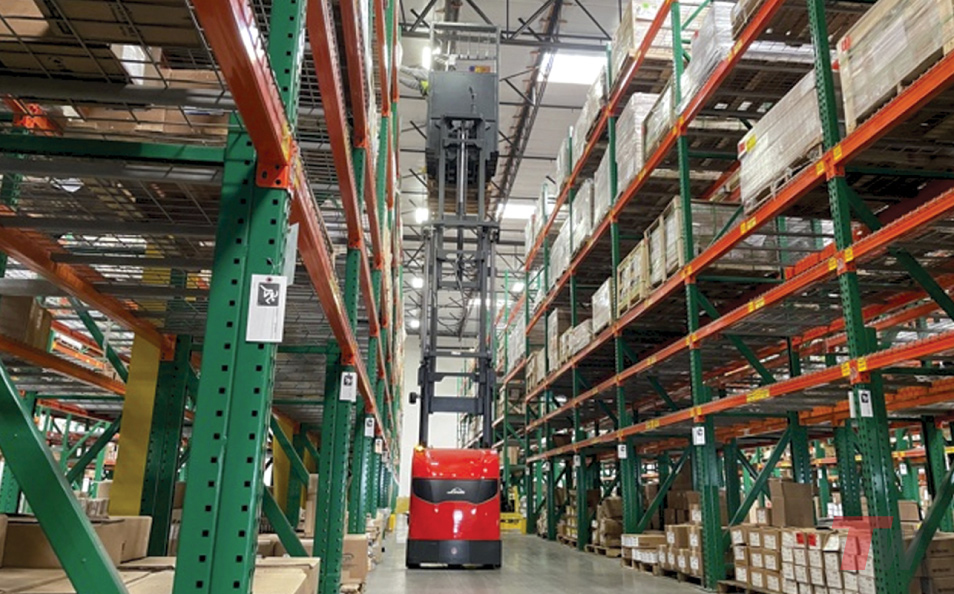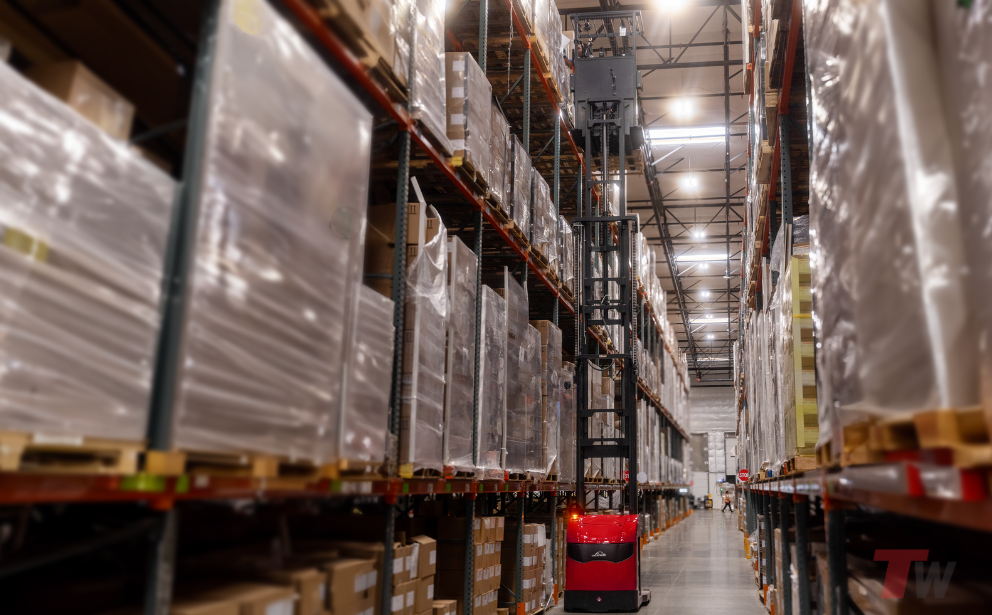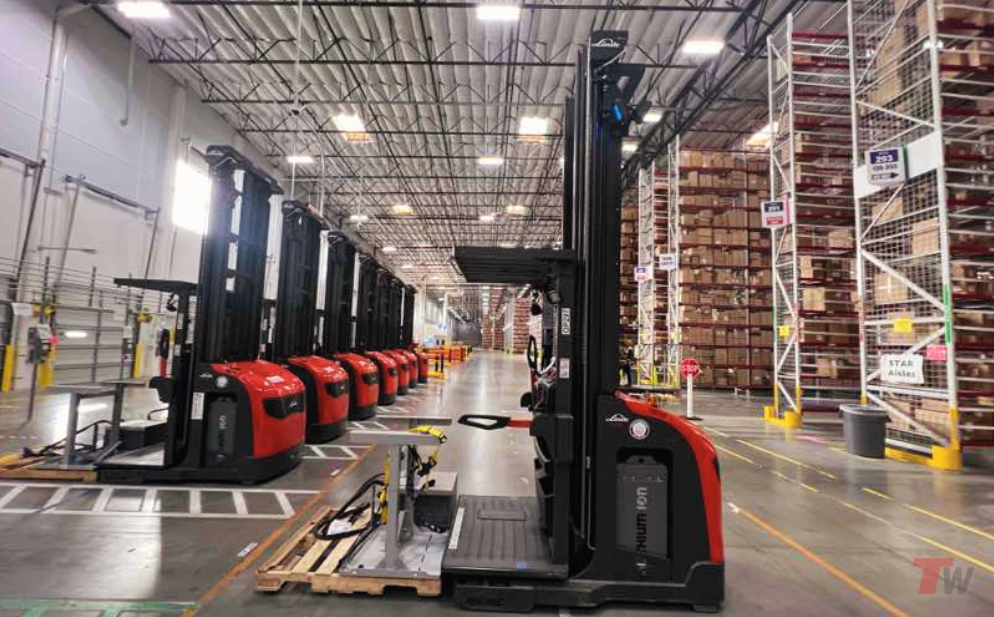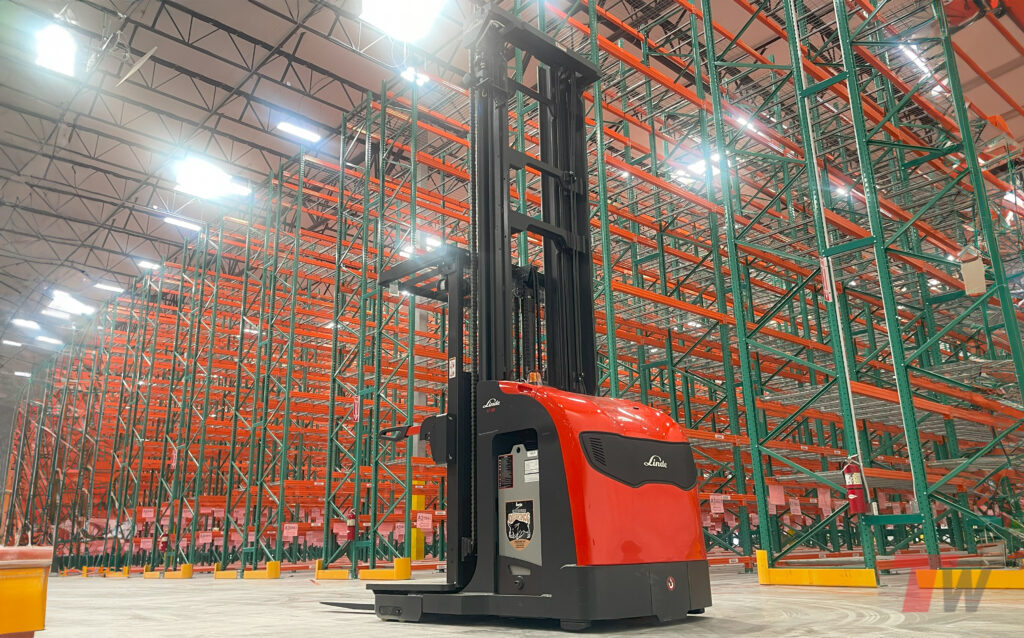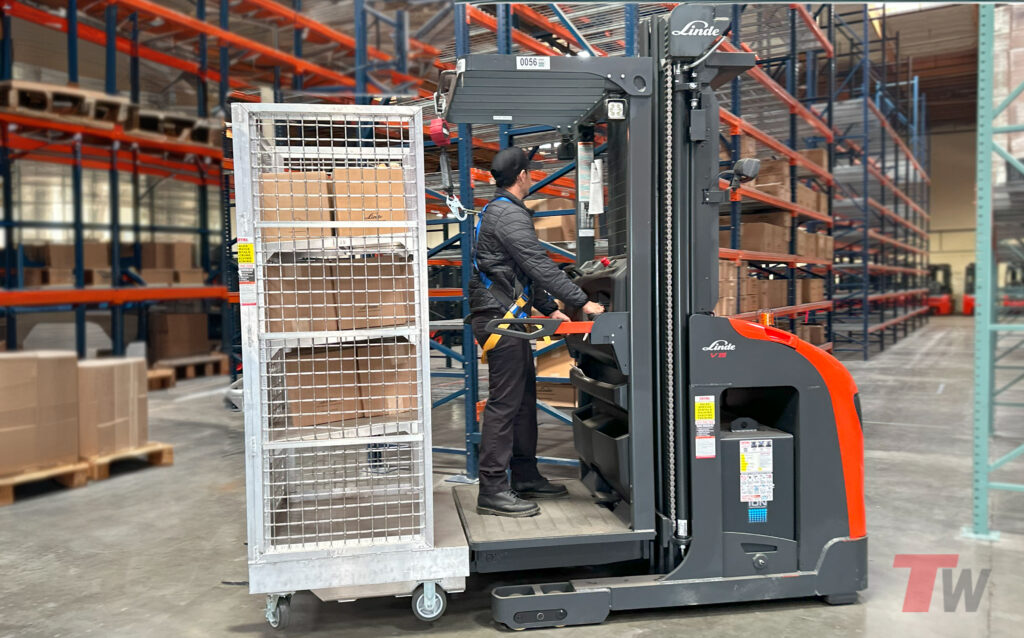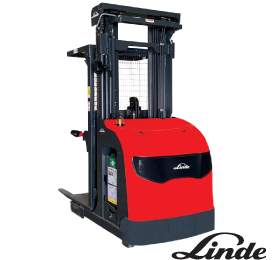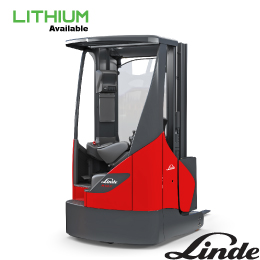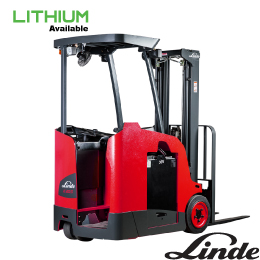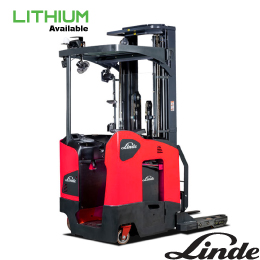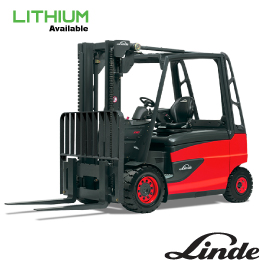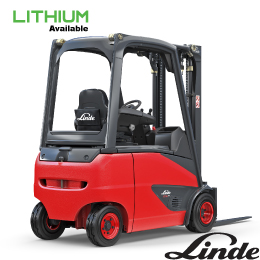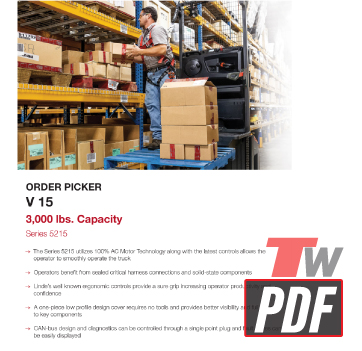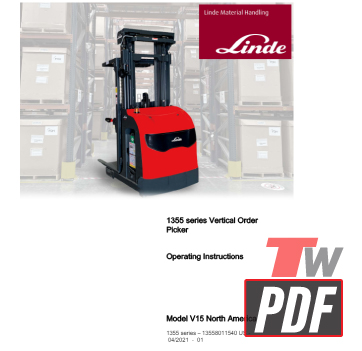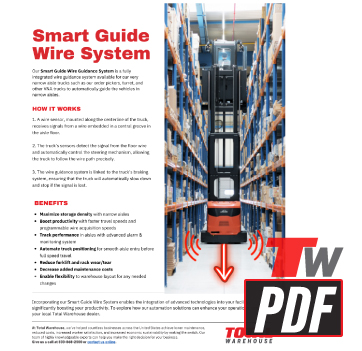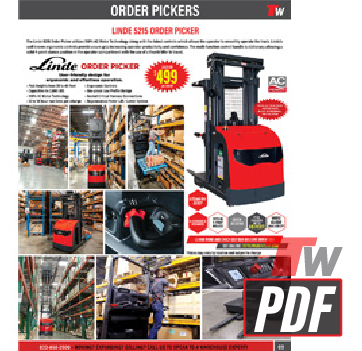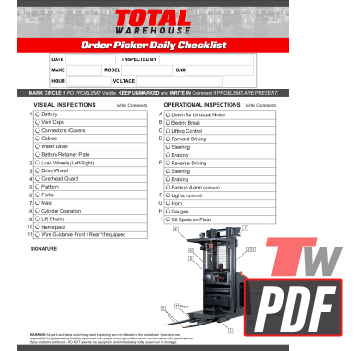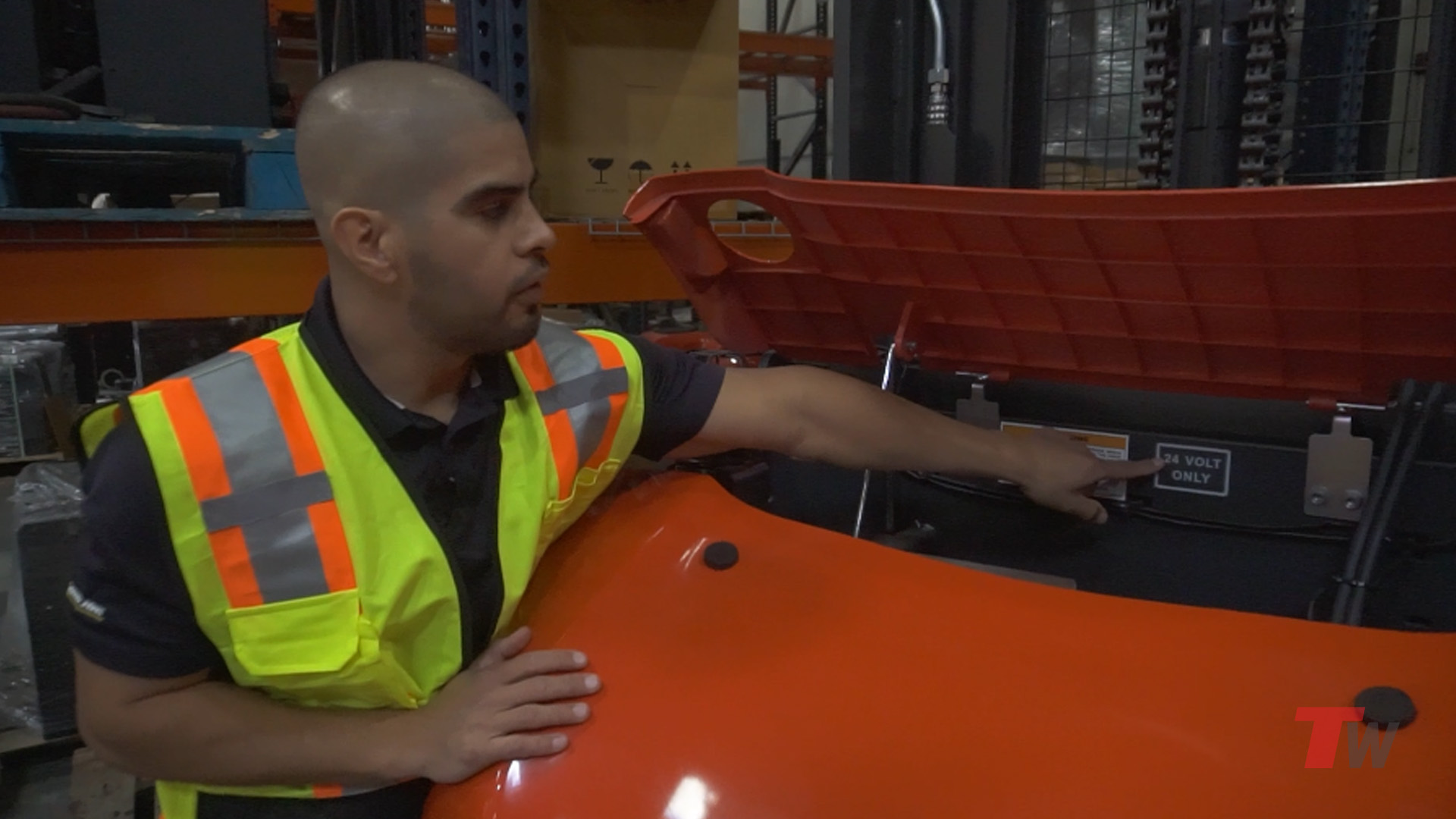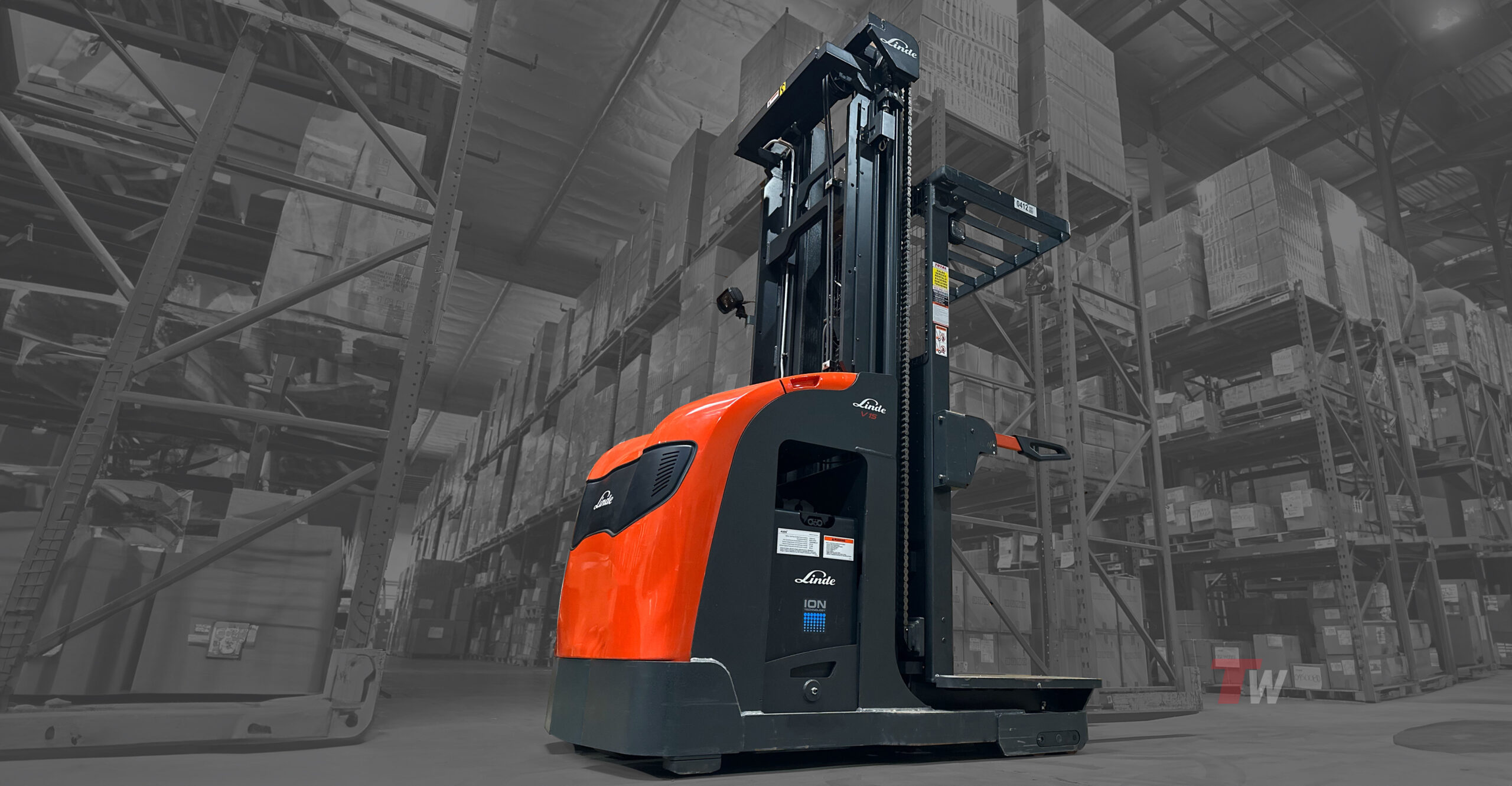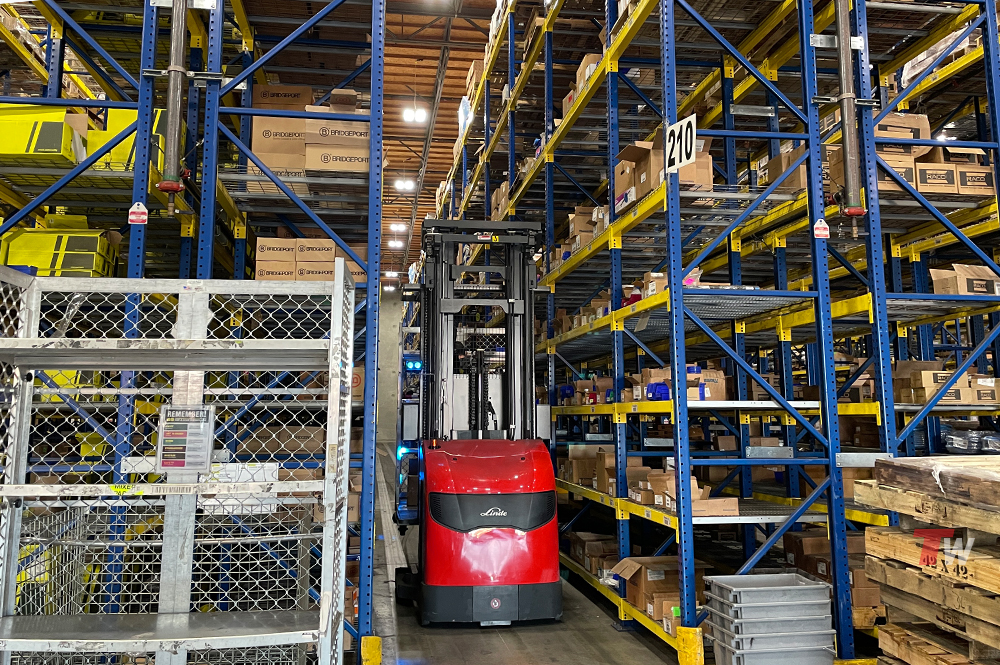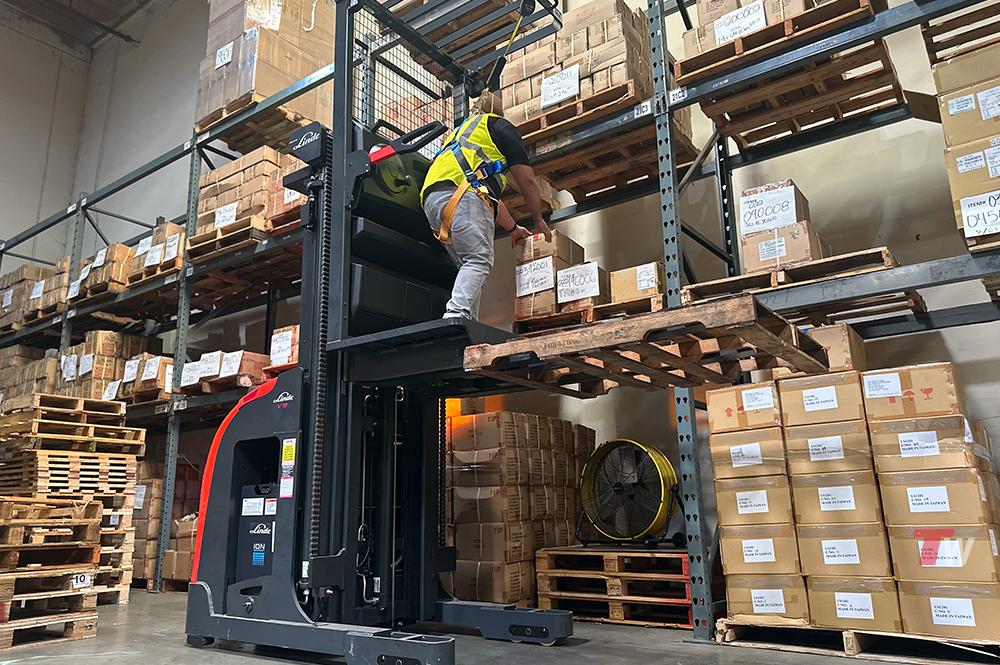Key Features
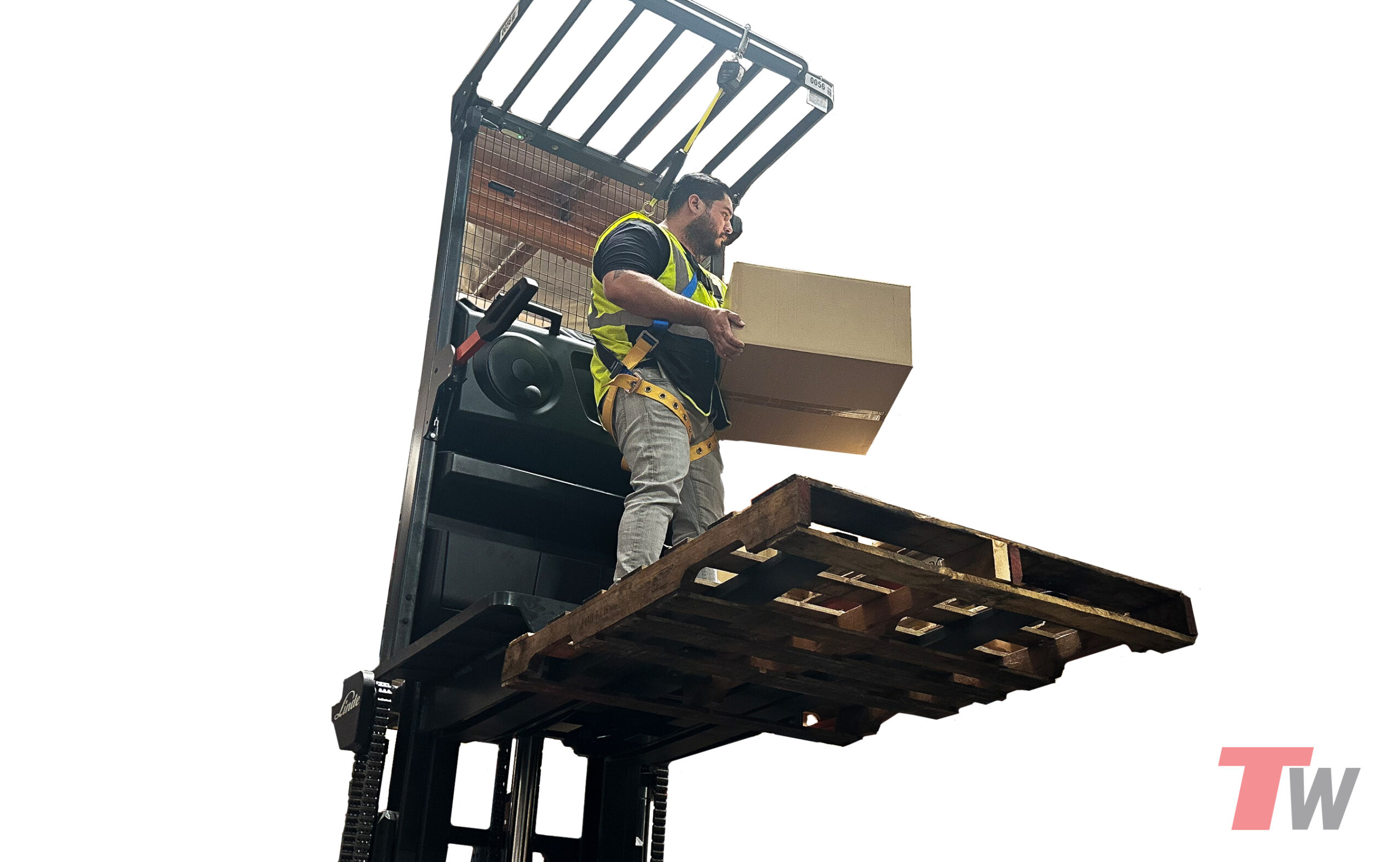
Unbeatable Stability with Steel Design
By utilizing steel extensively – from the mast to the side gates and everything in between – there is less sway and greater operator confidence, leading to increased productivity. During stops and starts from 30 feet above the ground, operators remain in touch with the stockpicker via four solid points contact.
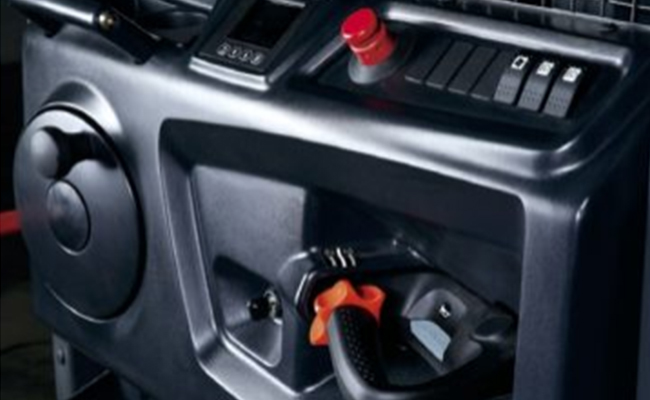
Ergonomic Multi-Function Control Handle
The Multi-Function Control Handle is stationary, allowing a solid 4-point stance position in the operator compartment with the use of a thumb tiller to travel. This adjustable handle has eliminated any wrist movements while keeping the operator feeling attached to the truck at all times.
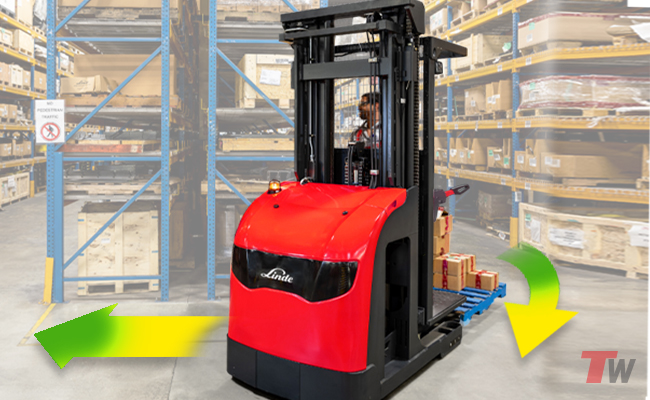
Enhanced Safety for Sharp Turns
The Linde Curve Assist System automatically reduces the speed of a forklift that is travelling too fast around a curve. If the operator drives too fast into a curve, or if the curve radius is too small, the centrifugal forces try to tip over the forklift — that’s where Linde Curve Assist comes in.
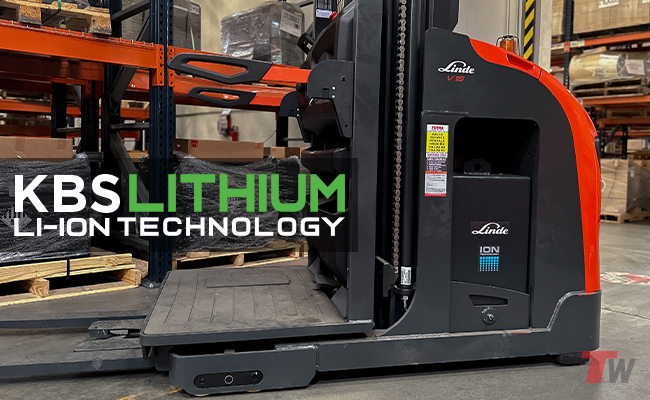
Electrify Your Operations with Lithium
Linde Li-ION batteries for forklift trucks and warehouse equipment improve operation and handling. They increase vehicle availability and make operation more economical, safer and more sustainable. Many users appreciate the practical advantages in their day-to-day work.
- Increased Sustainability
- Reduced Charging Time By 70%
- Low Operating Cost
- Longer Run Time
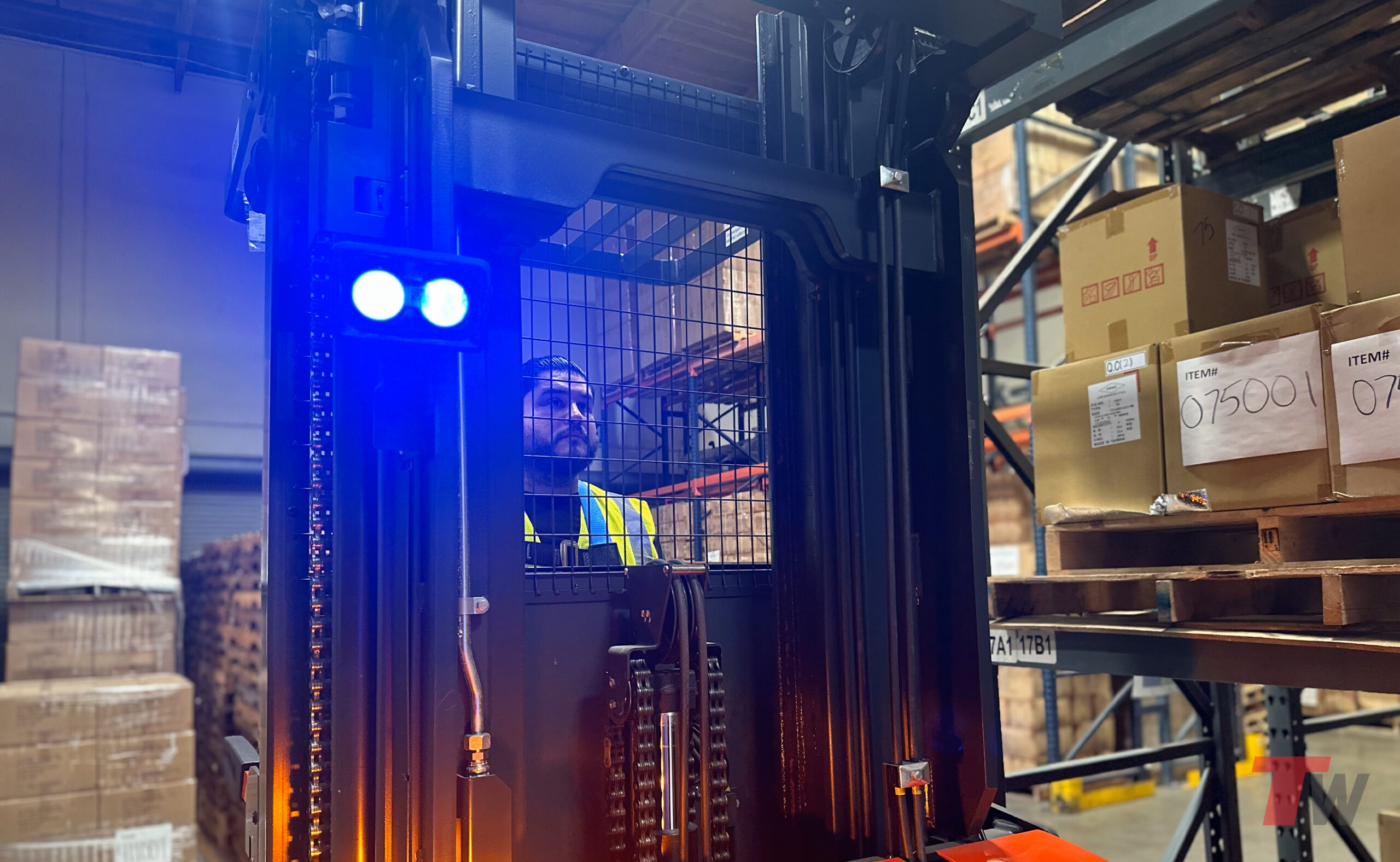
InnovativeLinde BlueSpot™
The InnovativeLinde BlueSpot™ driving path warning system minimizes risk without making a sound.
- Driving path warning system: Increasing safety in aisles and at crossings with poor visibility
- Early warning: A spot on the ground well ahead of the truck leaves plenty of time to move out of the way
- LED technology: Anti-glare, high-intensity light using low levels of energy
- Long service life: Very low operating temperature
- Durability: Resistant to shaking, vibrations, and high-pressure cleaning
- Diversity: LED light with a red or blue light spot or a blue arrow
- Well-received by drivers and pedestrians: No need for disruptive acoustic warning signals
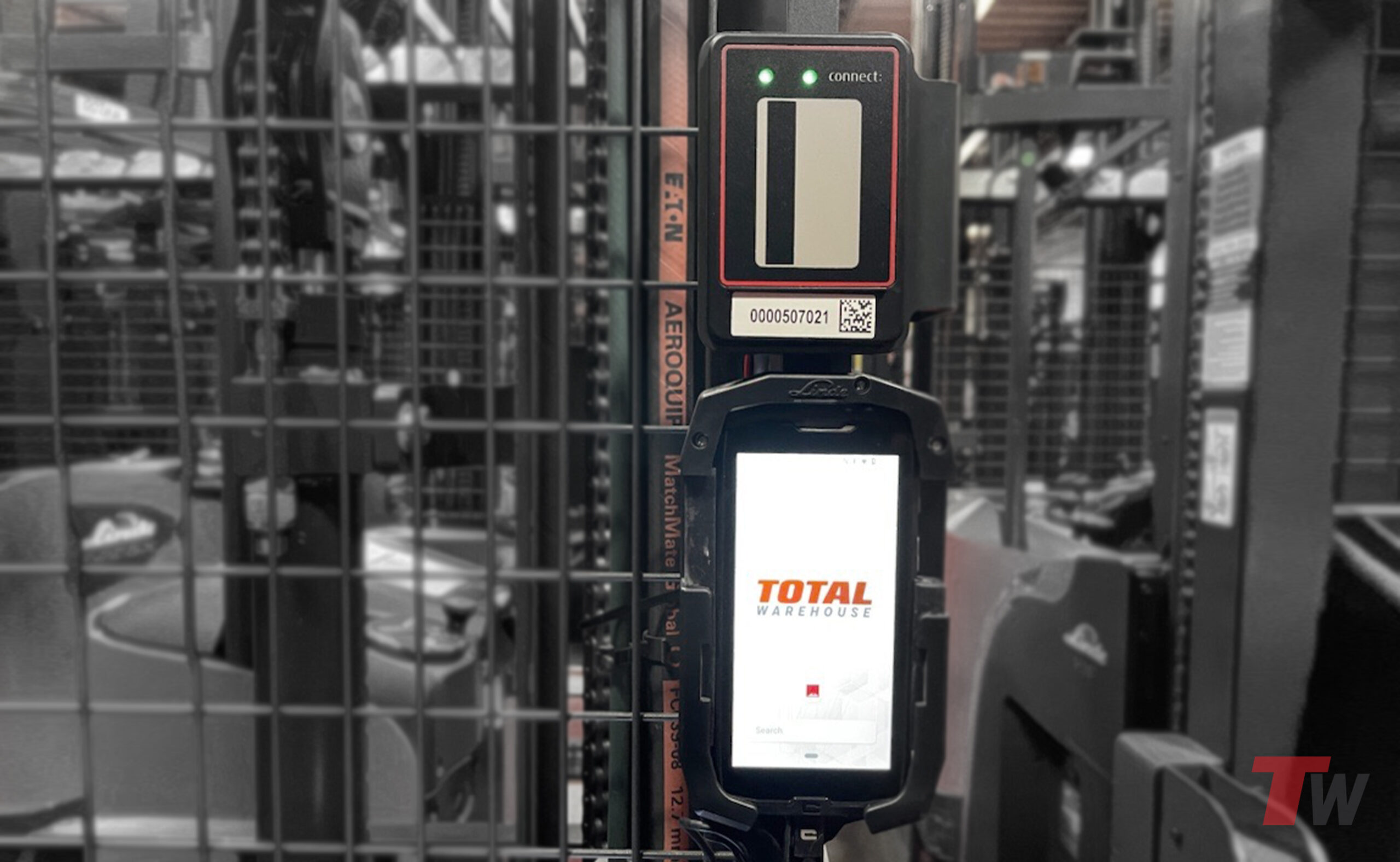
Advanced Technology
Work Assistance Accessories are designed to make operators’ jobs easier and more efficient, with many options to help keep frequently-used tools and accessories like laptops, clipboards or Linde Connect (pictured) close at hand.
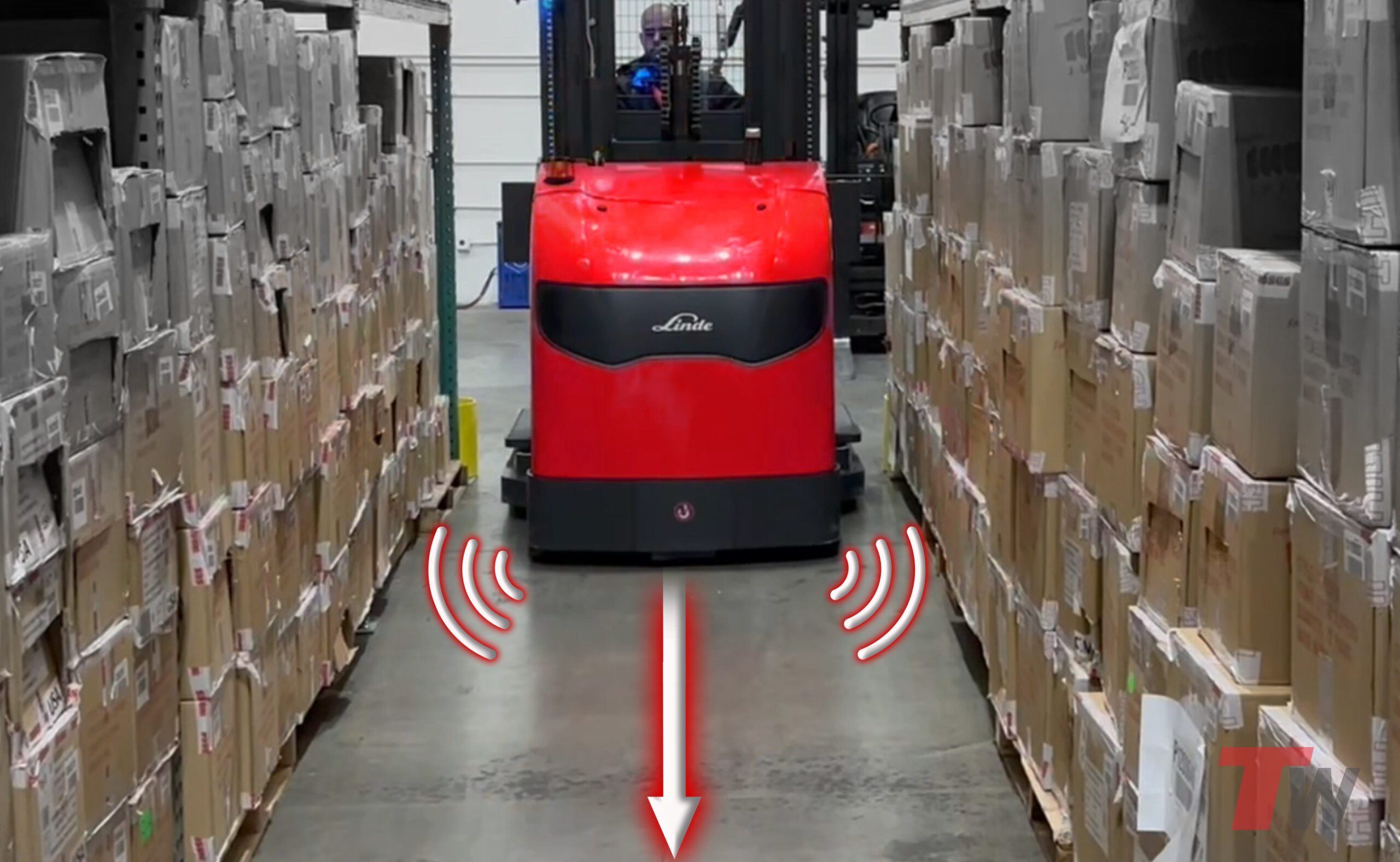
Linde Smart Guide: Automated Navigation for Narrow Aisles
The Linde Smart Guide Wire Guidance System is a fully integrated solution for narrow aisle lift trucks, including the 1355 Order Picker. A wire sensor on the truck detects signals from a wire embedded in the floor, automating steering for precise navigation. This system allows operators to focus on productivity, like order picking, by eliminating manual steering tasks.
Learn More About the Linde Smart Guide Wire Guidance System
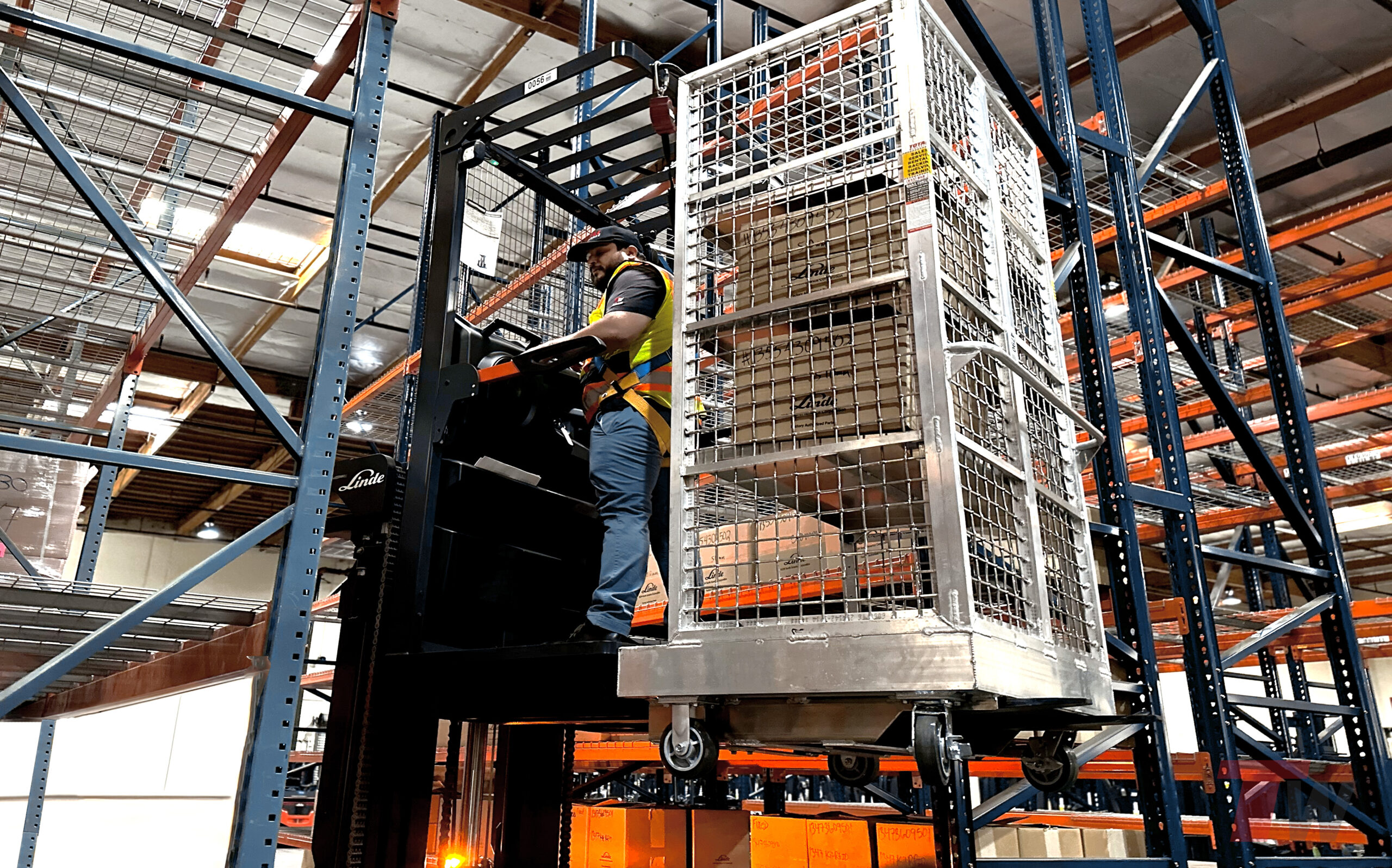
Efficient Order Picking
Our Order Picking Carts are designed to team up with an order picker, ensuring seamless fulfillment of your picking requirements. These can effortlessly accommodates large items, or switches gears for smaller ones when the shelf is down. With this unique design, there is no picking job that is too big or too small.
Elevate your Operations with this Powerful Addition to your Fleet.
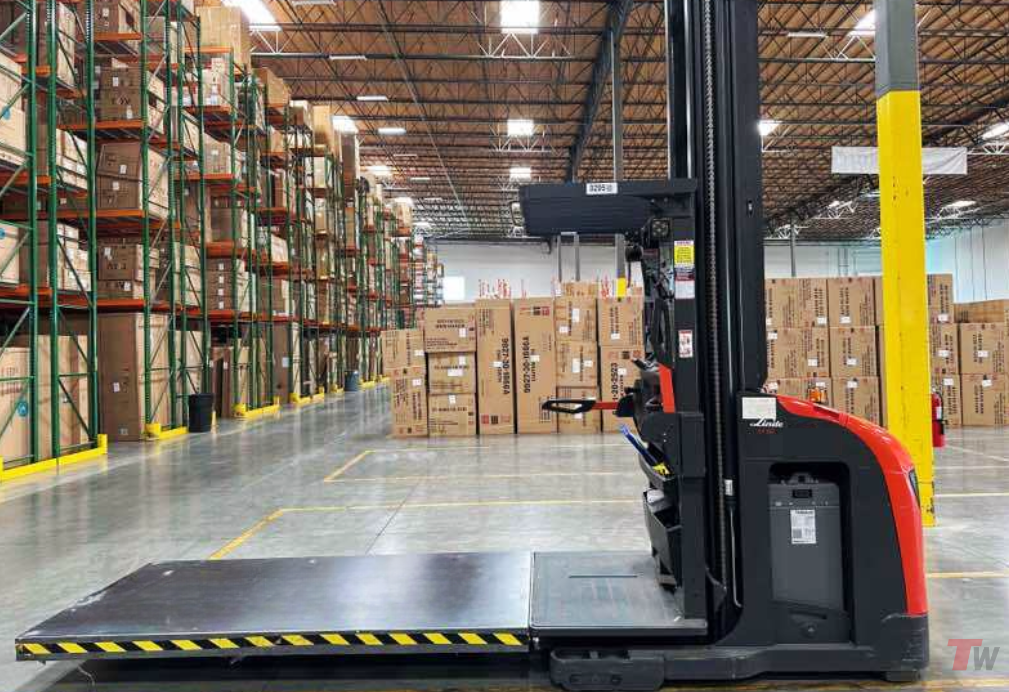
A Furniture Order Picker isn’t just valuable in warehouses; it’s versatile enough for distribution or retail settings too. Designed to endure the continuous use they undergo in today’s manufacturing facilities, warehouses, and distribution centers. Efficiently handle bulky, delicate and odd-sized loads with our specially equipped order pickers.
Whether you’re handling bulky furniture or large components, our Furniture Order Picker can handle the task.
Elevate your Operations with this Powerful Addition to your Fleet.
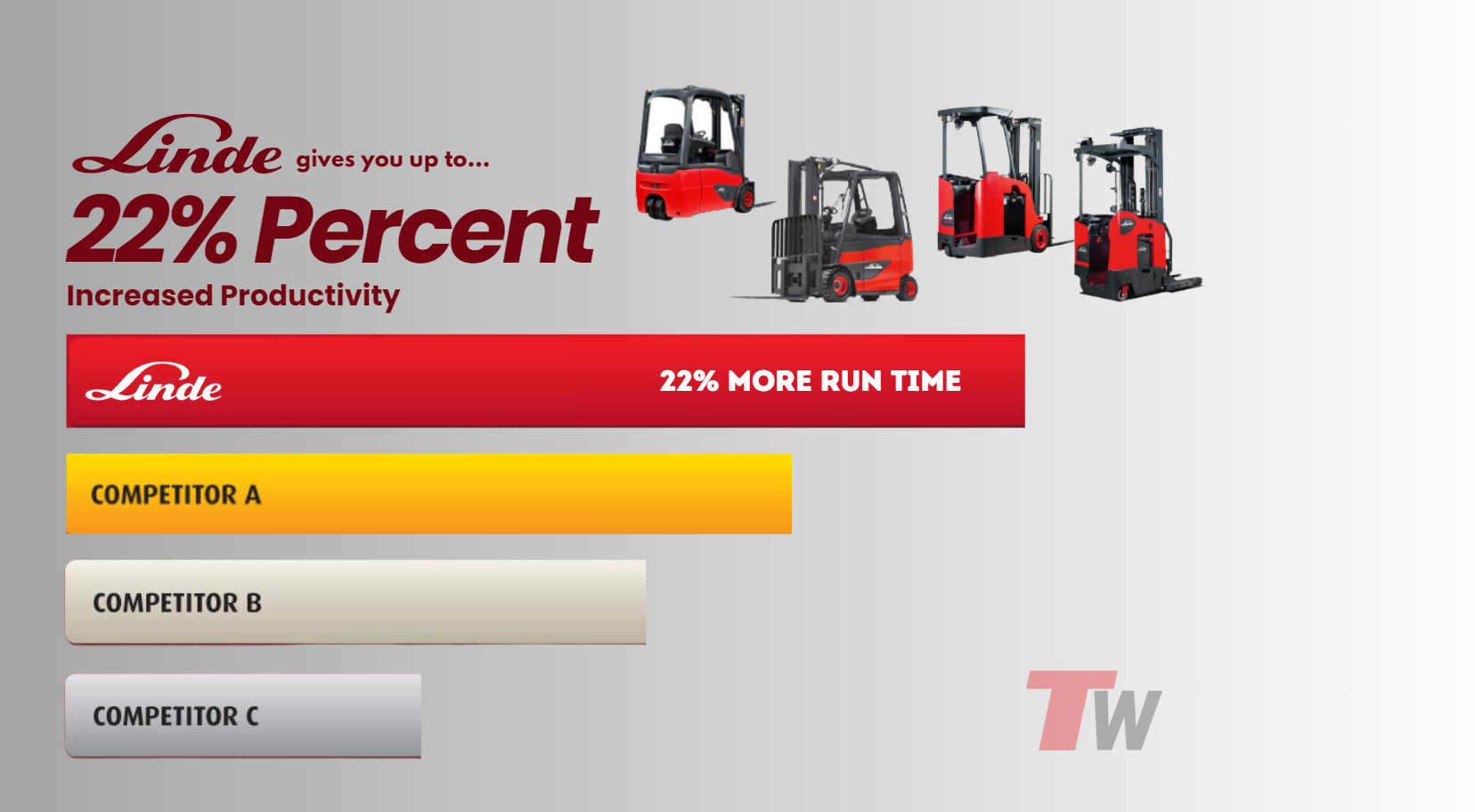
Global Leader in Forklifts
Linde Material Handling is a global leader in the manufacturing and production of forklift trucks and warehouse equipment, successfully providing the perfect forklift truck for every industry and application for over 60 years.
With their capability to handle diverse tasks and move heavy loads, Linde forklifts are trusted for their reliability and efficiency.
- Benefit from up to 40% savings on operating costs from efficient energy management.
- Linde forklifts are over 22% more productive compared to closest competitors.
Understanding Order Pickers
- Q:What is an order picker and how is it different from a forklift?
- A:Order pickers are designed for picking individual items from shelves, while forklifts primarily move full pallets. Order pickers typically offer narrower aisle maneuverability and elevate the operator alongside the load.
- Q:What industries and applications are order pickers best suited for?
- A:Common uses include retail distribution centers, e-commerce fulfillment, parts warehouses, and any facility with high-frequency picking of smaller quantities.
- Q:What are the main types of order pickers?
- A:Major types are:
- Low-level order pickers: Operator on a platform, picks at ground to low shelf heights.
- Mid-level order pickers: Operator picks up to mid-range heights
- High-level order pickers: Operator can reach top shelves in warehouses/narrow aisles
- A:Major types are:
- Q:What factors should I consider when choosing an order picker?
- A:Key factors include:
- Picking height required
- Aisle widths
- Order volume and throughput needs
- Floor surface conditions
- Operator preferences
- A:Key factors include:
Operational Features
- Q:How do you operate an order picker?
- A:Operation varies slightly by model, but generally, an operator uses a control panel to drive, lift/lower the platform, and often move the forks horizontally.
- Q:What are the typical lift heights for low, mid, and high-level order pickers?
- A:This varies within each category, but roughly:
- Low-level: Up to about 6 feet
- Mid-level: 6-12 feet
- High-level: 12 feet and up, some as high as 30+ feet
- A:This varies within each category, but roughly:
- Q:What is the average aisle width needed for order picker operation?
- A:Aisle width requirements can be as narrow as 4 feet for specialized “man-up” high-levels. More common aisle widths are 6-10 feet, depending on model and turning clearance needed.
- Q:Can order pickers be used on uneven floors or inclines?
- A:Most are designed for smooth, level concrete floors. Some rough-terrain models can handle mild unevenness, but always check specs for operating limitations.
- Q:What safety features are typically found on order pickers?
- A:Common features include:
- Guardrails
- Lanyards/harnesses
- Anti-slip surfaces
- Sensors to prevent movement when the platform is raised
- Emergency stop buttons
- A:Common features include:
- Q:Do order pickers require any special operator training or certification?
- A:Yes, OSHA requires formal training and certification for all who use elevated work platforms like order pickers.
General Order Picker FAQs
Q: What is an order picker?
A: An order picker is a specialized piece of warehouse equipment used to retrieve individual items or cases from storage racks at varying heights. Unlike a standard forklift, an order picker elevates the operator along with a platform. This ensures maximum efficiency and safety during the picking process.
Q: Why do I need an order picker?
A: Order pickers are essential for warehouses and distribution centers that:
- Deal with high order volumes consisting of individual items or cases.
- Have tall storage racks.
- Prioritize efficient and ergonomic order fulfillment.
Q: What are the benefits of using order pickers?
A: Order pickers provide several advantages:
- Increased productivity: Faster picking cycles compared to manual ladder methods.
- Improved accuracy: Reduces picking errors.
- Greater safety: Eliminates the hazards of ladders and unstable reaching.
- Enhanced ergonomics: Less strain and fatigue for operators.
Types of Order Pickers
Q: What are the different types of order pickers?
A: Here’s a breakdown of the primary order picker categories:
- Low-level order pickers: For picking items from the ground to lower shelf levels.
- Mid-level order pickers: For reaching mid-height shelves.
- High-level order pickers: Designed for accessing the tallest warehouse racks.
- Turret trucks (or man-up forklifts): Specialized for very narrow aisles, maximizing storage density.
Q: How do I choose the right type of order picker?
A: Consider these factors:
- Racking heights: Matching the reach of the picker to your warehouse infrastructure.
- Aisle width: Ensuring the picker’s maneuverability.
- Picking frequency: Whether you need low, medium, or intense performance.
- Order type: If picking full cases or individual items (or both).
Features and Specifications
Q: What are the key features of order pickers?
A: Essential features include:
- Lift height: Maximum elevation the platform can reach.
- Capacity: Weight the order picker can support (including operator and items).
- Platform size: Providing space for picked items and operator movement.
- Controls: User-friendliness and intuitive operator interface.
- Travel and lift speeds: Affecting overall picking efficiency.
Q: What are some crucial safety features for order pickers?
A: Look for these safety systems:
- Fall restraints: Mandatory harnesses and lanyards.
- Guardrails: To prevent falls from the platform.
- Emergency stop buttons: Accessible for quick reactions.
- Sensors: To detect obstacles and prevent collisions.
Cost and Maintenance
Q: How much does an order picker cost?
A: The price range is wide, depending on:
- Type: Basic low-level vs. advanced high-level.
- Features: Added options and customization.
- Brand: Reputation and build quality.
- New vs. Used: A used model can be more cost-effective.
Q: What are the maintenance requirements for order pickers?
A: Regular maintenance is vital and may include:
- Battery checks and charging (for electric models).
- Lubrication of moving parts.
- Inspections for wear and tear.
- Software updates (if applicable).
Choosing an Order Picker Supplier
Q: How do I find a reputable order picker supplier?
A: When selecting a supplier, consider:
- Range of options: Ensure they offer various order picker types.
- Expertise: Experienced with matching customers’ needs to equipment.
- After-sales support: Availability of maintenance, parts, and technical assistance.
- Reputation: Industry standing and reviews from other customers.
Q: Should I buy or lease an order picker?
A: Factors to weigh:
- Budget: Leasing may have lower upfront costs.
- Flexibility: Leasing can be better for short-term needs or upgrading.
- Ownership: Buying gives full control and potential asset value
Detailed Technical FAQs
Q: What type of power source do order pickers use?
A: Most order pickers are electric, powered by rechargeable batteries. Some less common order pickers may use internal combustion engines (propane or diesel), usually for heavy-duty applications.
Q: How long does the battery last on an order picker?
A: Battery life depends on several factors:
- Picker model: Capacity and efficiency.
- Usage intensity: Frequency of lifts and travel distances.
- Battery age: Degradation over time.
Many modern order pickers can operate for a full shift or longer on a single charge.
Q: What is the difference between AC and DC motors in order pickers?
A: Here’s a comparison:
- AC (Alternating Current): Generally better energy efficiency, less maintenance, smoother operation, though often a higher initial cost.
- DC (Direct Current): More responsive acceleration, potentially better for handling steep slopes, typically a lower upfront cost.
Q: What type of drive system do order pickers use?
A: Most operate with one of these systems:
- Rear-wheel drive: Typical for basic models, good maneuverability.
- Front-wheel drive: Better traction control, especially with loads.
- All-wheel drive: Best for maximum stability and challenging terrain.
Q: What is regenerative braking on order pickers?
A: Regenerative braking captures energy released during deceleration and feeds it back into the battery. This extends battery life and increases efficiency.
Operational FAQs
Q: How fast can order pickers travel?
A: This varies by model but a typical range is:
- Travel speed (lowered mast): Up to about 7-8 mph.
- Travel speed (elevated mast): Often significantly slower for safety.
Q: Can order pickers operate on inclines?
A: Yes, but most have incline ratings they cannot exceed. Ensure the order picker’s specifications can handle the gradients in your warehouse.
Q: What is aisle guidance technology for order pickers? A: Aisle guidance can involve:
- Wire guidance: Embedded wires in the floor for navigation.
- Rail guidance: Tracks for precision in very narrow aisles.
- Vision guidance: Cameras and sensors for more flexibility. These systems increase speed and safety in aisle operations.
Q: What is order picker training and why is it important?
A: Order picker training is mandatory due to operating heavy machinery at height. Training typically covers:
- Safe operation: Controls, maneuvering, load handling.
- Warehouse layout: Navigating your specific facility.
- Fall prevention: Proper harness and lanyard use.
- Emergency procedures: How to respond to various situations.
Q: Do I need a license to operate an order picker?
A: Requirements vary by location. Often, you’ll need specific in-house certification (based on OSHA standards or similar) along with a valid driver’s license.
Advanced Features and Technology
Q: What is task automation on order pickers?
A: Task automation can range from:
- Semi-automated travel: To programmed pick positions in aisles.
- Auto-lift/lower: The platform adjusts height based on shelf location.
- Vision picking systems: Augmented reality guides the picking process. These reduce operator fatigue and increase efficiency.
Q: How does warehouse management software integrate with order pickers?
A: WMS integration can:
- Optimize picking routes: Minimizing travel distances.
- Direct picker actions: Voice commands or screen guidance.
- Provide real-time inventory updates: Keeping data accurate.
Q: What are some other advanced features on modern order pickers?
A: Look out for:
- Pick-to-light systems: Lights indicate picking locations.
- Onboard scales: To verify order weights during picking.
- Operator comfort features: Adjustable platforms, padded surfaces, climate control.
Best Use-Cases
Q: Are order pickers suitable for cold storage environments?
A: Yes, there are models specifically designed for cold storage. These feature:
- Cold-rated components: Seals, lubricants, and electrical systems can handle low temperatures.
- Heated compartments: Maintain comfortable operator temperatures.
Q: Can order pickers be used outdoors?
A: Some order pickers can handle outdoor use, but consider these factors:
- Terrain: Designed for smooth warehouse floors or rough exterior surfaces.
- Tire type: Pneumatic tires may be needed for uneven ground.
- Weatherproofing: Protection from moisture and temperature extremes.
Q: Are order pickers a good choice for retail store replenishment?
A: They can be useful in certain scenarios:
- Large retail stores: With high shelves and backroom storage.
- Overnight restocking: When customer traffic is low.
- Order picking alongside pallet forklifts: For mixed stock types.
Q: Can I use an order picker to retrieve full pallets?
A: While not their primary design, some order pickers can:
- Handle modified pallets: Smaller size or adapted design.
- Feature pallet forks attachment: Must be rated for the picker’s capacity. Generally, standard forklifts are safer and more effective for full pallet handling.
Q: Which industries frequently use order pickers?
A: Order pickers are essential in:
- E-commerce fulfillment: High volume, individual item picking.
- Wholesale distribution: Case picking from extensive inventory.
- Retail backrooms: Replenishing high shelves in large stores.
- Manufacturing: Picking parts and components for assembly.
Q: What are the typical lead times for purchasing a new order picker?
A: Lead times can vary due to:
- Model availability: Popular models may be ready for quicker delivery.
- Customization: Options and attachments can increase lead times.
- Supplier backlogs: Check current lead times in your region.
Q: Does Total Warehouse offer used or refurbished order pickers?
A: Many suppliers do have a selection of used equipment. Ensure good condition and warranty coverage if going this route.
Q: Where can I find user reviews and comparisons for different order picker models?
A: Excellent resources include:
- Industry publications: Material handling magazines often have reviews.
- Online forums: See experiences from other warehouse operators.
- Supplier websites: May offer customer testimonials or case studies.
Troubleshooting and Common Issues
Q: The order picker won’t lift – what should I check?
A: Start with these areas:
- Battery charge: Ensure it’s properly charged.
- Emergency stop: Make sure it’s disengaged.
- Control fault: Look for error codes and consult the manual.
- Hydraulic leak: Check fluid levels and inspect hoses.
Q: The order picker feels unstable – what could be wrong?
A: Investigate these possibilities:
- Overload: Exceeding the weight capacity.
- Uneven load distribution: Shift picked items for better balance.
- Floor issues: Cracks or debris may affect stability.
- Tire problems: Look for low pressure or damage.
Accessories and Customization
Q: Can I add a barcode scanner to an order picker?
A: Yes, most order pickers can be fitted with barcode scanners. Consider placement and mounting options for ease of use by the operator.
Q: What other types of accessories are available for order pickers?
A: Popular accessories include:
- Clipboards/ document holders: For paperwork and order lists.
- Task lights: Improve visibility in low-light areas.
- Fall protection attachments: Additional anchor points for harnesses.
- Work trays or shelves: Expand storage space on the pick platform.
- Custom pallet forks: Designed to match the picker’s limitations.
Q: Does customizing an order picker affect the warranty?
A: It depends. Always consult the manufacturer or supplier:
- Approved modifications: May not affect the warranty.
- Unauthorized changes: Could void warranty coverage.
Ergonomics and Operator Comfort
Q: How do order pickers address operator fatigue?
A: Ergonomic features can reduce strain:
- Padded platforms: Minimizes foot and leg discomfort.
- Adjustable controls: Customizable placement for operator size.
- Power steering: Easier navigation, especially with loads.
- Entry/exit design: Low step heights, grab bars for safe access.
Q: Can order pickers accommodate operators with disabilities?
A: Some models may offer, or be adaptable with:
- Modified controls: Handheld, foot-operated, or voice-directed.
- Specialized platforms: Wheelchair accessibility design features.
- Assistive technology: Consult suppliers for specialized modifications.
Q: What is the noise level of order pickers?
A: This varies, but electric models are generally quieter than combustion versions. Noise levels are a factor in operator comfort, especially in long shifts.
The Future of Order Pickers
Q: How is automation changing the order picking process?
A: Automation trends include:
- Autonomous mobile robots (AMRs): Fetch items to picking stations.
- Goods-to-person (GTP): Systems bring shelves to the picker.
- Cobots (collaborative robots): Work alongside human pickers.
- Advanced software optimization: Improves efficiency at every stage.
Q: Will there always be a need for human-operated order pickers?
A: Yes, even with automation. Human pickers offer strengths in:
- Handling irregular-shaped items: Where robots may struggle.
- Visual inspections: Spotting product damage or quality issues.
- Adaptability: Changing order profiles and exceptions.
Q: What are emerging technologies to watch in order pickers?
A: Keep an eye out for:
- Augmented reality (AR): Overlaying pick visuals for operator guidance.
- Wearable tech: Enhancing data input and reducing handheld device use.
- Greater energy efficiency: Advanced battery and motor technology.
- Increased use of sensors: For obstacle avoidance and safety in shared spaces.
Q: Can I rent an order picker for a short-term project?
A: Yes, many suppliers offer rental options. This can be ideal for seasonal demand peaks or trying out a model before purchasing.
Q: What is the total cost of ownership for an order picker?
A: Factors beyond the initial price tag include:
- Maintenance costs: Scheduled, preventative, and unexpected repairs.
- Energy costs: Electricity for charging (and fuel if applicable).
- Operator training: Initial certification and ongoing refresher courses.
- Consumables: Tires, hydraulic fluids, etc.
- Depreciation: The decrease in value over the equipment’s lifetime.
Q: Are there financing options available for order pickers?
A: Yes, typical choices include:
- Equipment loans: Secured credit from banks or specialized lenders.
- Supplier financing: Offered directly by manufacturers or dealers.
- Leasing: May offer monthly payment plans with flexibility to upgrade.
Training and Regulatory FAQs
Q: What regulations govern the use of order pickers?
A: Primarily OSHA (Occupational Safety and Health Administration) standards in the US. Check your local regulations, but common areas include:
- Operator certification: Specific types of lift machinery.
- Fall protection rules: Harness requirements and lanyard connections.
- Workplace inspections: Ensure equipment is maintained and aisles are clear.
Q: How often does order picker operator certification need to be renewed?
A: This can vary, but typically refresher training is advised every few years to ensure operators stay up-to-date on best practices and safety regulations.
Q: Can I develop my own in-house training program for order pickers?
A: It’s possible but consider these factors:
- Meeting regulatory standards: Ensure the content aligns fully.
- Instructor expertise: Experienced personnel capable of training others.
- Hands-on training: Access to suitable order pickers for practice.
- Evaluation and testing: Verifying operator competency.
Situational and Niche FAQs
Q: Do I need a special floor surface for order pickers?
A: A smooth, level, concrete floor is generally ideal. Certain models can handle minor imperfections, but check specifications based on your warehouse conditions.
Q: Is an order picker a good choice for a start-up warehouse?
A: Factors to consider:
- Initial investment: Can be significant compared to ladders.
- Order volume: Justify the purchase if picking efficiency is needed from day one.
- Flexibility: Order pickers are less versatile than a standard forklift.
Q: Are there order pickers designed for tight spaces?
A: Yes! Look for:
- Turret trucks: Specifically designed for very narrow aisle widths.
- Compact models: Low-level pickers may have small footprints.
- Articulating chassis: Improved turning radius for maneuvering.
Q: Does the aisle width need to change if I switch to order pickers?
A: It may, depending on:
- Previous method: Manual vs. other equipment you were using.
- Type of order picker: Larger models typically need wider aisles.
- Guiding systems: Wire or rails can reduce navigation space needed.
Compatibility and Integration
Q: How do I ensure the order picker is compatible with my existing racking system?
A: You must consider:
- Height compatibility: Can the picker reach the top shelves?
- Aisle width: Can the picker maneuver safely with your rack spacing?
- Weight capacity: Is your racking sturdy enough for picker + operator + load?
- Guidance systems: Check if your aisles support wire/rail guided pickers.
Q: Can an order picker work with conveyors or other automated systems?
A: Yes, integration is often possible but may require:
- Software compatibility: Data flows between your WMS and picker systems.
- Conveyor height alignment: Does the picker platform line up for easy transfer?
- Safety interlocks: Prevent collisions or unexpected movement.
Q: Will my existing WMS need upgrades to accommodate order pickers?
A: Possibly, depending on the desired level of integration:
- Basic functionality: A WMS may already generate picking lists.
- Advanced features: Optimizing routes, pick-to-light integration, etc., may require updates.
Questions Customers May Overlook
Q: What are the benefits of used order pickers?
A: Consider used when:
- Budget is a priority: Can be significantly less expensive than new.
- Short-term need: Rental-like function without long commitments.
- Backup equipment: Redundancy if your primary picker is down.
Q: Does buying a used order picker impact safety?
A: Not necessarily, BUT you must:
- Source from reputable suppliers: Offering inspected equipment.
- Check maintenance history: Prioritize well-maintained pickers.
- Inspect thoroughly: Before purchase, verify condition and functionality.
Q: How does the age of an order picker affect its performance?
A: Older models may:
- Lack the latest safety features: Updated sensors and safeguards.
- Have less efficient technology: Slower speeds, shorter battery life.
- Experience reduced parts availability: Harder to find for repairs.
- Have outdated software: May not integrate well with modern systems.
Q: Are there regulations regarding the maximum age of order pickers in the workplace?
A: Not typically based on age alone, BUT:
- Safety inspections: Older equipment requires extra scrutiny
- Obsolete technology: Unsupported software can limit functionality.
- Employer preference: Companies may set internal policies on equipment age.
Q: Where can I find resources for troubleshooting or technical support for my order picker?
A: Here are the best places to start:
- Manufacturer’s website: Often have manuals, FAQs, and contact details.
- Supplier/dealer: Where you purchased may offer direct support.
- Online forums and communities: Tap into experiences of other users.
- Third-party maintenance specialists: Can be hired for complex issues.
Q: Can I operate the order picker controls while wearing gloves?
A: This depends on:
- Glove type: Thicker gloves can affect fine motor control.
- Control panel design: Touchscreen vs. traditional buttons.
- Manufacturer features: Some offer glove-friendly interfaces.
Q: Do order pickers come in different platform sizes?
A: Yes, platform sizes vary to accommodate:
- Single vs. multiple operators: Some platforms are compact, others more spacious
- Case volume: Picking larger batches may require bigger platforms.
- Special purpose: Extra-long platforms for awkwardly shaped items.
Q: Do order pickers have anti-slip surfaces?
A: Most do! It’s crucial for operator safety when stepping on and off the platform. Look for textured or coated surfaces on steps and the platform itself.
Q: Is there a risk of tipping with order pickers?
A: The risk is minimized through design, BUT improper use can increase it:
- Overloading: Never exceed the picker’s load capacity.
- Speeding: Taking corners too quickly, especially when raised.
- Uneven floors: Potholes or debris can throw a picker off balance.
- Operator inattention: Not adhering to safety rules.
Comparing Order Pickers to Alternatives
Q: When is a ladder sufficient instead of an order picker?
A: Ladders are acceptable only for:
- Infrequent picking: Very low order volumes make pickers inefficient.
- Low rack heights: Where ladders can safely reach needed items.
- Very limited budgets: Initial investment may be a major barrier.
Q: Should I consider a scissor lift instead of an order picker?
A: Scissor lifts are better for:
- Maintenance and installation: Where vertical reach is the primary need.
- Heavy-duty jobs: Often have higher weight capacity than pickers.
- Stationary work: Not designed for frequent movement within aisles.
Q: How does an order picker compare to a walkie stacker? A: Choose an order picker when:
- Efficient item picking is the priority: Faster than dismounting a stacker.
- High rack heights: Walkie stackers have limited reach.
- Ergonomics matter: Operator rides along rather than walks beside.
Tackling Customer Worries
Q: Are order pickers noisy enough to disrupt other warehouse operations? A: Electric order pickers are relatively quiet. Issues may arise with:
- Open warehouse layouts: No barriers to dampen sound.
- Old or poorly maintained pickers: Worn components can make more noise.
- Combustion engine models: (if applicable) inherently louder.
Q: Are order pickers easy to learn to operate? A: They require specific training, but most operators adjust well due to:
- Intuitive controls: Joysticks and control panels are often designed for quick mastery
- Safety features: Built-in systems reduce the risk of operator error.
- Proper onboarding: Well-structured training is crucial.
Q: Does using an order picker increase the risk of product damage? A: It can decrease it! Compared to manual picking:
- Less fatigue: Operators are less likely to drop or mishandle items.
- Stable platform: Easier to place items securely at various heights.
- Safer reach: Reduces unbalanced stretching that can cause damage.
Q: Does OSHA require a specific license to operate an order picker? A: OSHA requires certification on powered industrial trucks. The specific licensing varies slightly by state, so checking local regulations is crucial.
Specific Use Cases
Q: Can order pickers handle different pallet sizes? A: Some have flexibility, but it’s vital to check:
- Platform dimensions: Must fit the intended pallet type.
- Weight capacity: Can the order picker handle the loaded pallet.
- Attachments: Fork adapters may be needed for specific pallets.
Q: Can order pickers be used in temperature-controlled storage? A: Yes, however, you’ll need a model designed for this:
- Cold-rated components: Can operate and maintain battery life in low temperatures.
- Heated operator compartment: For environments below freezing.
Q: Are fall protection systems on order pickers comfortable for the operator? A: Modern harnesses have improved comfort with:
- Padding: Reduces rubbing and chafing for all-day wear.
- Adjustability: Custom fit reduces strain and restriction.
- Breathable materials: Minimize overheating for operators.
Q: Does using order pickers require changes to my warehouse layout? A: Possibly, optimize efficiency gains might come from:
- Aisle widths: May need adjustments based on picker turning radius.
- Traffic flow: Separate pedestrian and equipment routes for safety.
- Product slotting: Optimize picking routes based on picker order/speed.
Operational Concerns
Q: How often do order pickers need maintenance? A: There are multiple types of maintenance needed:
- Daily checks: Basic inspections by the operator before use.
- Scheduled preventative maintenance: Based on manufacturer’s intervals (hours, mileage, etc.)
- Unscheduled repairs: Addressing breakdowns or unexpected wear.
Q: What is the average lifespan of an order picker? A: Lifespan depends heavily on:
- Usage intensity: High-volume warehouses wear equipment faster.
- Maintenance: Well-maintained pickers last significantly longer.
- Quality of build: Reputable brands often have greater longevity. A well-cared-for picker can last 10+ years, though technology may outpace it even if functional.
Q: Are there any potential environmental impacts of order pickers? A: Here’s the breakdown:
- Electric models: Minimal direct emissions, carbon footprint tied to power source.
- Combustion models: Produce emissions like other gas-powered vehicles.
- Disposal: Batteries and components need proper end-of-life recycling.
Cost Analysis FAQs
Q: What are the hidden costs of owning an order picker? A: Budget for ongoing expenses like:
- Energy: Electricity to charge batteries, and fuel as applicable.
- Maintenance: Parts, labor, and service technician costs.
- Training: Initial certification and refresher courses for operators.
- Warehouse optimization: Potential layout changes to maximize the picker.
Q: Does using order pickers impact my labor costs? A: Typically, yes, in several ways:
- Reduced picking labor: Fewer operators needed vs. manual methods.
- Specialized training: Certified order picker operators may command higher wages.
- Maintenance personnel: May need in-house or on-contract mechancis.
Q: How do I calculate the ROI (Return on Investment) of an order picker? A: Consider these factors:
- Productivity gains: Increased picks per hour compared to previous methods.
- Labor cost savings: Reduced wages or potential to reallocate manpower.
- Accuracy improvements: Decreased picking errors save on returns/corrections.
- Reduced damage: Safer handling translates to cost savings on product loss.
Comparisons and Advanced Use Cases
Q: How do order pickers compare to voice picking systems? A: Both enhance the picking process but in different ways:
- Order pickers: Physical elevation, better for visual identification.
- Voice picking: Hands-free operation, good for rapid, sequential picks. Hybrid approaches combining them are being adopted in some warehouses.
Q: Can order pickers be used for inventory cycle counting? A: Yes! Their advantages for this include:
- Reach: Allows visual checks of items on high shelves.
- Barcode integration: Scanners confirm quantities during counts.
- Accurate location data: Improves overall inventory tracking.
Q: Does the color of an order picker have any practical purpose? A: Though aesthetics play a role, color is mainly for:
- Visibility: Bright colors make them stand out in busy warehouses.
- Branding: May match company colors or distinguish picker types.
- Safety markings: Highlighting hazard areas on the order picker itself.
Q: Can order pickers be used on inclined warehouse floors? A: Most are designed for level surfaces. Check these if inclines are present:
- Manufacturer’s gradeability limitations: Exceeding this voids safety protocols.
- Load weight: Increased risk of stability issues on a slope.
- Alternative equipment: Forklifts may be better suited if inclines are frequent.
Handling Fragile Products
Q: Are there special order pickers for fragile items? A: While not exclusive, look for these features:
- Padded platform: Cushions items during transport.
- Shock-absorbing mechanisms: Counteracts bumps and rough aisles.
- Precise controls: Smooth lifts and fine movement reduce breakage.
- Attachments: Specialized fork coverings or cradles for specific fragile goods.
Q: How do I minimize breakage of fragile items when using an order picker? A: Alongside picker choice, operational practices are crucial:
- Operator training: Emphasize delicate handling techniques.
- Protective packaging: Bubble wrap, dividers within picked cases.
- Secure loading: Proper stacking and use of straps on the platform.
- Route planning: Choose smoother warehouse zones if possible.
Hazardous Materials
Q: Does OSHA permit regular order pickers for hazardous materials? A: This depends heavily on the type of hazardous material:
- Non-flammable, low-risk substances: May be safe with precautions.
- Chemicals, flammables, etc.: Require specialized, hazmat-rated equipment.
- Always consult with OSHA guidelines based on specific substances.
Q: What special features do order pickers need for hazardous materials? A: Focus on safety and spill prevention:
- Spark-proof construction: Reduces ignition risks.
- Sealed components: Protect electronics in volatile environments.
- Chemical-resistant coatings: Handle spills or exposure.
- Spill containment trays: On the picker platform itself.
Handling Oddly Shaped/ Bulky Items
Q: Can order pickers handle long or awkward-shaped items? A: Yes, with adjustments or specialized models:
- Extended platforms: Offer more support for lengthy objects.
- Removable side rails: Accommodate wider loads.
- Custom attachments: Can secure unique geometries (i.e., pipes, rolls).
- Turntable platforms: Help operators rotate unwieldy items for access.
Q: Are there weight limitations to consider when picking bulky items? A: Absolutely! Even more than standard picking:
- Overall load capacity: Must account for item weight + operator.
- Load distribution: Uneven weight creates tipping risks.
- Center of gravity: Awkward shapes shift the load balance.
Extreme Environments
Q: Do explosion-proof order pickers exist? A: Yes, designed for highly flammable atmospheres:
- Spark elimination: All electrical components are contained or spark-resistant.
- Temperature control: Prevents motors and wiring from overheating.
- Specialized certification: Ensure it meets the class/division needed for your hazard.
Q: Are there order pickers designed for outdoor yard operations? A: Some models focus on outdoor capability:
- All-terrain tires: Handle uneven ground and varying surfaces.
- Weatherproofing: Seals electrical components against moisture.
- Cabin enclosures: Operator comfort in wind, rain, etc.
- Increased stability: For potentially windy outdoor environments.
Specialized Industries
Q: What features are important for pharmaceutical warehouse order pickers? A: Prioritize accuracy and cleanliness:
- Precise small pick capabilities: Handling individual medications.
- Cleanable surfaces: Easy to sanitize or maintain sterile environments.
- Temperature control: May need refrigeration if handling sensitive products.
- Lot tracking integration: Software compatible for strict stock control.
Q: Does the food and beverage industry need specialized order pickers? A: Often, they seek features regarding:
- Hygiene: Stainless steel, easily washable surfaces.
- Cold storage capability: For picking from freezer zones.
- Case handling: Designed for standard food-grade crates and bins.
- Wash-down tolerance: If sanitation involves high-pressure cleaning.
-
Q: What are some key features I should look for in an order picker? A: Features to consider include:
- Lift height capabilities
- Load capacity
- Travel speed
- Operator platform size and comfort
- Safety features
- Power source (battery or AC)
- Technological options (wire guidance, pick-to-light systems, etc.)
-
Q: What is lift height, and how is it important? A: Lift height is the maximum vertical distance an order picker can raise the operator platform. It directly determines the shelving heights you can access.
-
Q: What does load capacity mean for order pickers? A: Load capacity refers to the maximum weight an order picker can safely lift and transport.
-
Q: What factors influence an order picker’s lift capacity? A: Factors include:
- Mast type
- Machine’s size and build
- Hydraulic system capability
- Outrigger design (on certain models)
-
Q: What safety features should I be aware of on order pickers? A: Common safety features include:
- Guardrails and safety harnesses
- Emergency stop buttons
- Anti-collision sensors
- Audible and visual warnings
- Overhead guards
Operational Considerations
-
Q: How long does the battery last on an electric order picker? A: Battery life depends on usage intensity, battery capacity, and model. Some batteries can last a full shift or more, with charging systems designed for fast turnaround.
-
Q: What are the advantages and disadvantages of electric vs. gas-powered order pickers? A:
- Electric:
- Advantages: Cleaner emissions, quieter operation, lower maintenance costs
- Disadvantages: May need extended charging times, less suitable for outdoor use
- Gas-powered (Internal Combustion):
- Advantages: Faster refueling, better for heavy-duty loads
- Disadvantages: Noisier, exhaust fumes, require more maintenance
- Electric:
-
Q: How fast can an order picker travel? A: Travel speeds vary but generally range from a few miles per hour to up to 6-7 mph for certain models.
-
Q: What is the average turning radius of an order picker? A: Turning radius depends on the model and aisle widths. Some are built for extremely tight maneuvers, especially turret trucks in very narrow aisles.
-
Q: What are the different types of masts on order pickers? A: Common mast types include:
- Single-stage mast: Simplest design, suitable for low heights.
- Two-stage mast: Extends in two stages, providing greater lift heights.
- Three-stage mast: Offers the highest lift capabilities for reaching top shelves.
-
Q: Does mast type affect load capacity? A: Yes, typically higher stage masts provide more lift height but might have slightly reduced load capacities at their maximum extensions. Always check the manufacturer’s specifications.
-
Q: How do I know if an order picker has the right lift height for my warehouse? A: Measure the height of your tallest shelving. Add several feet for operator safety and maneuverability to determine the needed minimum lift height.
-
Q: Can I customize the mast or lift height? A: Some manufacturers offer customizations or different mast options for specific models. Contact your supplier to explore custom options.
-
Q: What factors limit lift height on an order picker? A: Factors include:
- Warehouse ceiling height
- Mast type and design
- Stability at full extension
- Load weight and distribution
-
Q: What is the relationship between lift height and stability? A: As lift height increases, stability can decrease, especially with heavier loads. Manufacturers design equipment with safety and stability in mind, but operators must always follow capacity guidelines.
-
Q: Do order pickers have load capacity charts? A: Yes, they have detailed charts indicating the safe load capacity at various lift heights for each model.
-
Q: Where can I find the load capacity chart for a specific order picker? A: Refer to the manufacturer’s product specification sheet or consult a dealer of that brand.
-
Q: What should I consider when selecting an order picker based on load capacity? A: Analyze the following:
- Typical weights of items you pick
- Whether some orders involve extra heavy or bulky items
- Leave some margin to ensure capacity is never exceeded
-
Q: Does order picker travel speed change at higher lift heights? A: Yes, many models reduce speed at greater heights as a safety precaution.
-
Q: Can I increase the lift height and capacity of an existing order picker? A: Generally, no. These parameters are integral to the equipment’s design, and aftermarket modifications could compromise safety and stability.
-
Q: Do order pickers have weight sensors? A: Some models have overload sensors that alert the operator or restrict further lift if the load capacity is exceeded.
-
Q: Can I operate an order picker on uneven surfaces? A: Order pickers are primarily designed for smooth, level warehouse floors. Uneven surfaces significantly increase the risk of tipping and should be avoided.
-
Q: Are there order pickers made specifically for outdoor use? A: While most are designed for indoor use, some specialized models have features suitable for outdoor operation, like larger tires and more robust construction.
-
Q: Can forklifts replace order pickers? A: While forklifts can transport and lift items, they lack the precision, operator ergonomics, and safety features of specialized order pickers for order-fulfillment tasks.
-
What is free lift on an order picker mast? A: Free lift refers to the height the forks or platform can be raised before the inner mast sections extend. This means an order picker with free lift can enter the bottom of a pallet for better positioning within some racking types.
-
Q: What is the difference between standard lift and full free lift? A:
- Standard Lift: Platform and inner mast move upward proportionally. Used in many applications.
- Full Free Lift: The platform rises a certain distance independently before the entire mast begins to extend, allowing you to work within restricted spaces like low entryways or below racks.
-
Q: Can order pickers lift an operator and products at the same time? A: Yes, most are designed to carry the operator on an elevated platform alongside their picked items.
-
Q: Are there weight restrictions for the operator on an order picker? A: Yes, operator weight is always factored into the safe load capacity of the machine. Check the specifications sheet for details.
-
Q: Does the weight of the order picker itself affect capacity? A: Absolutely. The overall load capacity includes the combined weight of the machine, operator, and carried items.
-
Q: How is load center important for order picker capacity? A: Load center is the distance from the backrest of the forks to the center of gravity of the load. Incorrectly balanced loads can upset stability and exceed capacity even with lightweight items.
-
Q: Do order pickers have outriggers or stabilizers? A: Some high-level pickers incorporate outriggers or stabilizers, especially those designed for narrow aisles where added stability is crucial.
-
Q: Why are mast sway and deflection important? A: Some movement when the mast is extended is natural, but excessive mast sway or deflection can decrease stability and picking accuracy. Check the manufacturer’s tolerances for mast movement.
-
Q: How does aisle width affect my choice of order picker mast? A: Narrow aisles may require specialized high-reach masts or turret trucks, while wider aisles offer more flexibility for standard and two-stage masts.
-
Q: Can I add extensions to my order picker mast? A: Modifying the mast after purchase is generally not recommended due to safety and stability concerns. Always consult the manufacturer before making any alterations.
-
Q: How often should I inspect the order picker’s mast and lift mechanism? A: Follow the manufacturer’s recommended maintenance schedule. Daily visual inspections for damage are also crucial.
-
Q: What certifications or standards should order picker masts meet? A: Look for certifications relevant to your region (ANSI, OSHA, etc.), ensuring standards for construction and safety are met.
-
Q: Does temperature affect the operation of the order picker mast?
-
A: Extreme temperatures can affect hydraulic fluid viscosity and other parts of the equipment. Some order pickers are designed for freezer or cold storage environments.
-
Q: Can I repair or replace individual parts of my order picker mast?
-
A: Yes, most manufacturers supply readily available spare parts for their equipment. Always have repairs by a qualified technician.
-
Q: What signs indicate my order picker mast may be damaged or compromised?
-
A: Watch for:
- Visible cracks or bends
- Difficulty lifting or lowering
- Excessive swaying or noise
- Leaking hydraulic fluid
Competitive Rates
Available for Rent, Lease, and Sale
Total Warehouse has a massive rental fleet ready to be delivered to your business at a moment’s notice. We offer daily, weekly, and monthly rental rates that allow you to maximize operations at the bare minimum cost. We have you covered with the top material handling products for operational optimization that is customized to your specific needs.
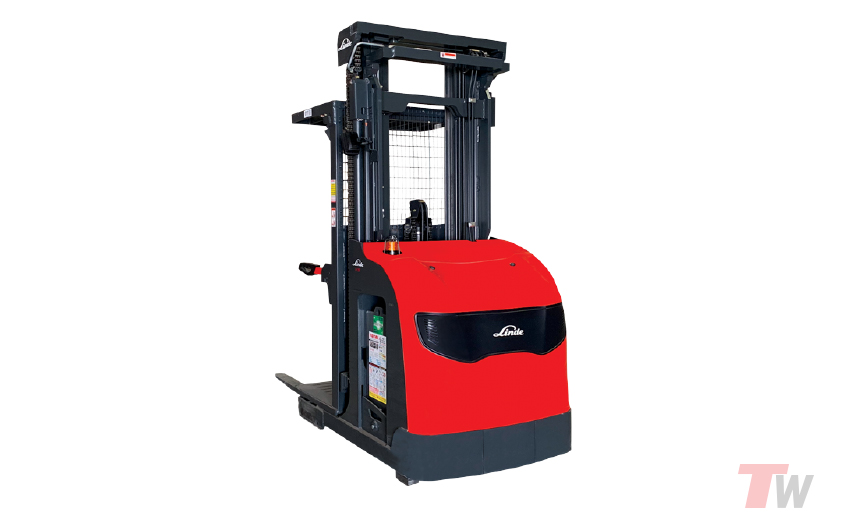
Task Support Vehicle
The Order Picker comes with proven Linde components from the drive unit to the AC electric motors. A number of engineering tests have been performed including FEA (finite element analysis) and Hydropulse for durability of frame and components over extended periods of time. Outriggers are solid steel welded to the frame separate from the mast assembly, with the goal of achieving a rigid frame for greater loads at extended lift heights up to 360”.
Still not convinced?
Let us help you decide.
The warehouse experts at TOTAL WAREHOUSE have decades of experience with every type of industry and operation. We know the exact equipment and storage system combination needed to increase your output. Give us a call and let's grow your business together.

